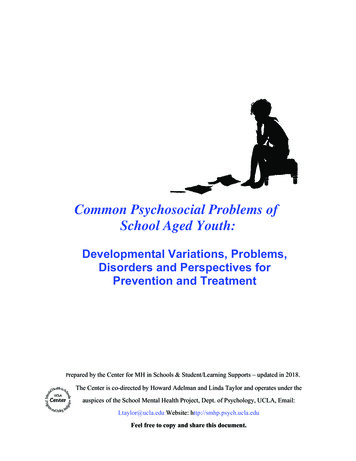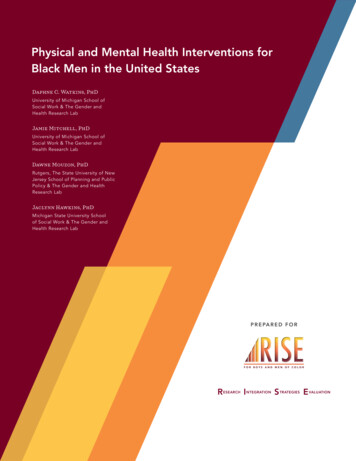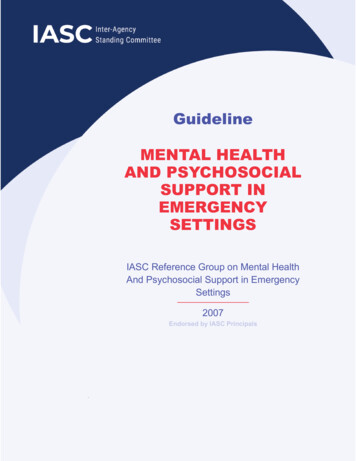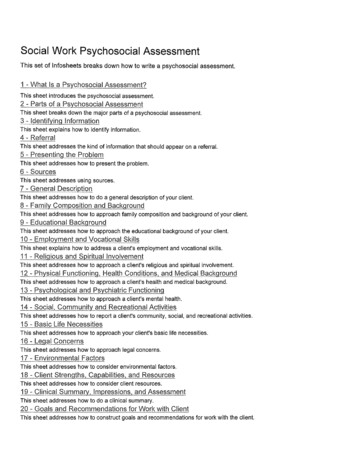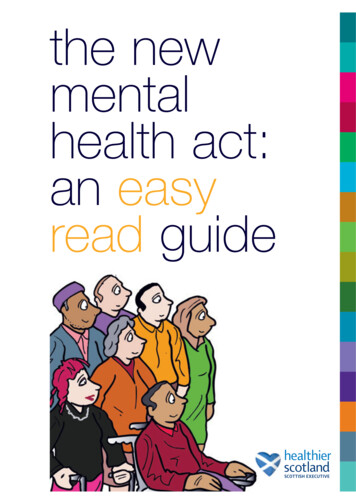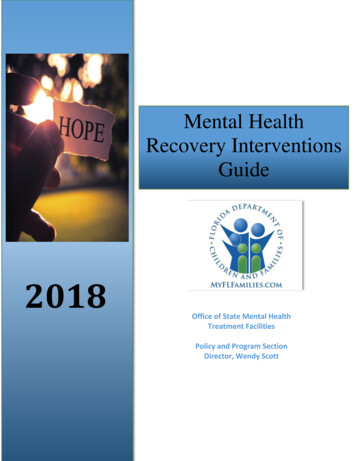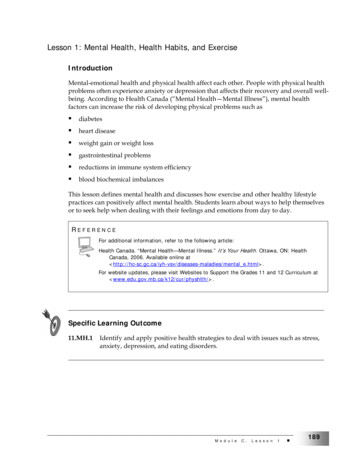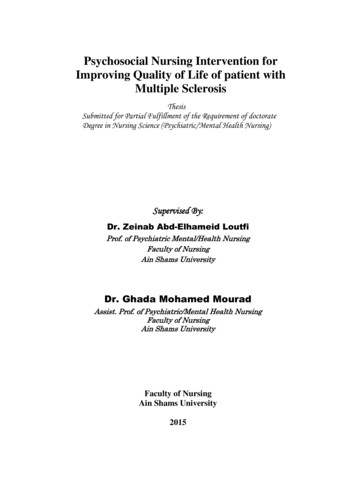
Transcription
PsychosocialInterventions inMental HealthNursing00 Walker - Psychosocial Interventions Prelims.indd 110/16/2014 6:15:22 PM
Chapter 1An introduction to psychosocialinterventionsWendy TurtonNMC Standards for Pre-registration Nursing EducationDomain 1: Professional values4.1 Mental health nurses must work with people in a way that values, respects and exploresthe meaning of their individual lived experiences of mental health problems, to provideperson-centred and recovery-focused practice.5. All nurses must fully understand the nurse’s various roles, responsibilities and functions, and adapt their practice to meet the changing needs of people, groups, communities and populations.Domain 2: Communication and interpersonal skillsMental health nurses must practise in a way that focuses on the therapeutic use of self. Theymust draw on a range of methods of engaging with people of all ages experiencing mentalhealth problems, and those important to them, to develop and maintain therapeutic relationships. They must work alongside people, using a range of interpersonal approachesand skills to help them explore and make sense of their experiences in a way that promotesrecovery.5.All nurses must use therapeutic principles to engage, maintain and, where appropriate,disengage from professional caring relationships, and must always respect professionalboundaries.5.1 Mental health nurses must use their personal qualities, experiences and interpersonalskills to develop and maintain therapeutic, recovery-focused relationships with peopleand therapeutic groups. They must be aware of their own mental health, and knowwhen to share aspectsNMC Essential Skills Clusters (ESCs)Cluster: Care, compassion and communication6. People can trust the newly registered graduate nurse to engage therapeutically andactively listen to their needs and concerns, responding using skills that are helpful,providing information that is clear, accurate, meaningful and free from jargon.402 Walker - Psychosocial Interventions Ch-01.indd 410/16/2014 6:15:31 PM
An introduction to psychosocial interventionsBy entry to the register:7. Consistently shows ability to communicate safely and effectively with people providing guidance for others.8. Communicates effectively and sensitively in different settings, using a range ofmethods and skills.Chapter aimsAfter reading this chapter, you will be able to: define what psychosocial interventions (PSIs) are and their role in effective, person-basedmental health care; provide opportunities to consider mental health care within a psychosocial framework; clarify the theoretical underpinnings of PSIs; consider the challenges of delivering PSIs in routine mental health care.Introduction: psychosocial interventionsCase studyMarianne lives with recurrent depression and this time round has been off sick from her job for fivemonths; this latest episode of low mood has caused her to become anxious about returning to work; shehas lost confidence in herself and wonders how she will cope with the inevitable questions from her workcolleagues. Marianne received a comprehensive psychosocial package of care from her mental healthteam. Working alongside Marianne, her care team identified that to promote and sustain recovery, sheneeded appropriate but minimal medication to support her mood. This was as an adjunct to a courseof CBT for her depression, to enable Marianne to understand her vulnerability to depression and learnskills to prevent relapsing into a further episode. Marianne’s husband received support from the carer’ssupport worker so that he could understand more about depression and so be a pivotal support forMarianne’s recovery. Vocational support was given to Marianne and her employer’s HR departmentto support a staggered return to her workplace and Marianne received support with accessing the localleisure centre to begin increasing her level of exercise. Lastly, Marianne was also supported to accessbibliotherapy to develop her confidence in managing her mood vulnerability and well-being. Mariannehas been discharged for two years now and has not experienced a relapse into depression.Psychosocial interventions are a group of non-pharmacological therapeutic interventions whichaddress the psychological, social, personal, relational and vocational problems associated with mentalhealth disorders. Psychosocial interventions address both the primary symptoms of the mental healthproblem and the secondary experiences which arise as a consequence of the mental health problem;as such PSIs are a person-based intervention rather than a solely symptom-based treatment. There502 Walker - Psychosocial Interventions Ch-01.indd 510/16/2014 6:15:32 PM
Chapter 1are many different therapeutic models and techniques that fall under the umbrella of PSIs such ascognitive behavioural therapy (CBT), dialectical behavioural therapy (DBT), supported employment, and peer support, and we will return to these different techniques and models later in thechapter; some are termed psychological therapies but they do come under the PSI umbrella.The PSIs offered to the person experiencing mental health difficulties will depend on the type ofproblem they are experiencing and their comprehensive needs, taking into account the impact thatthe mental health problem has had on their lives. Psychosocial interventions take an overview of theperson’s unique situation, which is why a comprehensive and collaborative assessment process isnecessary. Interagency working is also necessary because the various forms of PSI offered to theindividual may come from a number of different sources. For example, someone experiencingpsychosis and living with their family may be offered cognitive behavioural family interventions work(CBFI), while someone living with emotionally unstable personality disorder may be offered DBT;both may be offered vocational or educational support and possibly peer support with a view toreducing isolation. The choice is supported through the evidence base for the various therapies andinterventions and the findings which support efficacy of the interventions. Following systematicreview of available evidence, the National Institute for Health and Care Excellence (NICE)Guidelines for various mental health disorders also recommend specific PSIs.No matter what model or technique is utilised, the aim of PSIs is to promote, support and maintain recovery by providing: a framework for a comprehensive and meaningful assessment ensuring all elements ofexperience which are pertinent to promoting and maintaining recovery are covered; support which is meaningful and psychotherapeutic; a framework for developing a bio-psychosocial understanding of the person’s experience,developed collaboratively with the person; psychological interventions which reduce distress; psychological therapy to explore personal psychological vulnerabilities which leave a personopen to ongoing mental health problems; psychosocial interventions which reduce the interference the mental health difficulties haveon the person’s life; support to reconnect with the social world and so reduce the deleterious impact of socialexclusion and isolation; support to consider educational and employment opportunities; support to regain or develop skills which assist in self-care and activities of daily life; cognitive remediation to enhance concentration and cognitive processes.Case studyChelsea is 29 years old. Chelsea dropped out of school when she was 15 and spent three years ‘sofasurfing’ with friends to avoid sleeping at home. Chelsea was sexually abused by two of her mum’s shortterm partners when she was 8 and 14, and emotionally abused and neglected by her mum over many602 Walker - Psychosocial Interventions Ch-01.indd 610/16/2014 6:15:32 PM
An introduction to psychosocial interventionsyears. Chelsea found employment in various cafés and takeaways and has thrown away her dream ofgoing to university and making something of her life. Chelsea was finally re-housed by the council butten years on, finds her life can still be chaotic. She has been self-harming by cutting since she was 9,and has had periods when she minimised this and times when she was self-harming frequently. She hasmoved the body area of cutting so that it is not visible to her customers and her employers. People atwork view her as bubbly, if more than a little ‘crazy’; she is very impulsive and can fly off the handlesometimes. They also note that Chelsea’s mood is very changeable from extremes of happiness to moroseness and anger, often triggered by the slightest of things. At home Chelsea often becomes distraught anduses alcohol to help her cope with her feelings. She does not cope well with endings or change, and isfrequently lost in self-loathing and often feels alone and misunderstood. The friends she makes seem todrift away when they get to know her and Chelsea believes this is because they see her as damaged; thetruth is more that they find her inconsistent mood and behaviour difficult to tolerate. Just recently herlatest boyfriend has ended their relationship because of her ‘moods’. Chelsea finally agrees that she needssome help to change the way she gets through her life and her GP refers her to the Mental HealthAssessment Team who accept the referral.Activity 1.1Critical thinkingWhat would a comprehensive assessment with Chelsea reveal in terms of her needs andwhat areas might we need to consider addressing in order to promote sustainable changein Chelsea?An outline answer to this activity is provided at the end of the chapter.PSIs have gained momentum over the past two decades because of the growing recognition ofpsychological processes in the development and maintenance of common and more severe mental health problems. Equally more and more evidence informs us that social isolation, societalstigma and self-stigma are common experiences for people experiencing mental health problems and can impede recovery. We know the havoc mental health problems can wreak on allaspects of a person’s life, and that merely reducing symptoms will not create a holistic recovery.The strengthening position of the recovery movement in mental health has also supported thefostering of treatment regimens based on PSI rather than a reliance on medication alone.The psychosocial dimensionSometimes in mental health we feel manoeuvred into taking a narrow perspective on people’s recovery and find ourselves moving people on from mental health services when biological treatmentsappear to have stabilised the current health crisis; this situation means that the wider ramificationsof a period of mental ill health are not addressed. The psychosocial dimension includes relapseprevention, our sense of ourselves, our aspirations, our relationships, employment, education, social702 Walker - Psychosocial Interventions Ch-01.indd 710/16/2014 6:15:32 PM
Chapter 1inclusion, our ability to live independently and healthily, our sense of security in our world, ourphysical health and many more.Activity 1.2ReflectionDimensions of our livesReflect on how many aspects of your life there are, what roles you take in your life, whatresponsibilities, pleasures, stresses and aspirations you have.Imagine yourself experiencing high levels of anxiety; reflect on how living with this anxietywould impact and compromise your current life. What difficulties would it create? Whatmight you not be able to continue doing? What might you lose because of the anxiety?Every health problem has a psychosocial dimension so recovery must be supported within this dimension concurrently with any appropriate pharmacological and physiological treatments. Psychosocialinterventions are not in essence anti-pharmacological, but are equally effective as pharmacologicaltreatment in some disorders, e.g. depression (NICE, 2009) and are recommended as concurrentinterventions with pharmacological treatments in other disorders, e.g. psychosis (NCCMH, 2014).The best treatment regimens use both in parallel, ensuring that the psychosocial intervention isdelivered in a professional and ethical manner and the medication is prescribed at the minimumefficacious dose; such concurrent treatments can arguably increase self-agency in recovery.Mental health nursing and psychosocialinterventionsPSIs are a central element of a mental health nurse’s role. Your key skills are comprehensive andcollaborative assessment of a person’s mental health needs, knowing the recommendations forefficacious intervention in mental health problems, gaining clinical skills in some of the psychosocial therapies used in treatment, and understanding the importance of the psychosocialdomain in treatment and recovery. Care co-ordination itself supports a psychosocial approach tointervention because such a holistic approach needs a central person to co-ordinate the rangeof interventions that are appropriate and to signpost or refer to other agencies.Case studyDerek is 46 years old. Derek has never married but had a steady long-term job with the local counciland a healthy social network mostly with his friends from work. During his life Derek has had anumber of short-lived episodes of low mood which he says went away with getting stuck into work,having a short holiday, supported by taking a short course of anti-depressants. He moved toHampshire five years ago to be nearer to his elderly mother after the death of his father. Since moving802 Walker - Psychosocial Interventions Ch-01.indd 810/16/2014 6:15:32 PM
An introduction to psychosocial interventionsto Hampshire Derek has been the main carer for his mum, whilst struggling to hold down a job withthe local council. Nine months ago Derek hurt his back whilst decorating and has been in constantpain since then. He is on long-term sick leave from work but is now on Statutory Sick Benefit andstruggling financially. Derek reported to his GP that his mood has lowered again, but that there isnothing that can bring it back up. Derek feels as if his life is a failure, he cannot work, cannot lookafter his mum, and has no respite from his worries and racing thoughts. He feels despairing andpessimistic. He feels trapped, lonely and hopeless.Activity 1.3Team workingAs a care co-ordinator, identify the psychosocial needs that Derek has. What other agenciesand professional disciplines might you need to involve in this care? How would youco-ordinate the range of PSIs indicated as appropriate in Derek’s holistic recovery-led care?An outline answer to this activity is provided at the end of the chapter.Training and expert clinical supervision are a must to support PSI delivery. When we as nursesidentify that a PSI is appropriate for someone’s treatment we must ensure that it is delivered atan appropriately high standard and that the quality of the intervention is rigorously monitored.Some forms of PSI require more training than others; CBT and DBT (two of the psychologicaltherapies under the PSI umbrella) for example require professionally led clinical training followed by structured clinical supervision, whereas PSIs that focus on employment or educationalneeds will have a different training and supervision structure, and some PSIs such as using acognitive behavioural approach to intervention can be supported through less intense trainingand good supervision – but using this approach for example is not the same as delivering CBT,and it is important that we know what we are delivering and are aware of the limitations of ourknowledge and skills. It is equally important that we do not undertake to deliver PSIs that we donot thoroughly understand or have not received appropriate training for, particularly so whenwe are considering the psychological therapies.Theoretical underpinnings of psychosocialinterventions: the stress-vulnerability modelPsychosocial interventions are underpinned by the stress-vulnerability model of health; it isimportant that we spend some time in this introductory chapter familiarising ourselves with thiskey concept.Whilst there were earlier writers developing the stress-vulnerability model, Zubin and Springoffered a seminal paper on this model in 1977 focusing particularly on psychosis, and other902 Walker - Psychosocial Interventions Ch-01.indd 910/16/2014 6:15:32 PM
Chapter 1writers have continued the development of the model since and considered it as a framework forwider psychopathology (e.g. Nuechterlein and Dawson, 1984; Ingram and Luxton, 2005). Withinthis model both the impact of stress on the individual and their predisposing vulnerabilities arerecognised determinants of health. In mental health, this model supports the understandingthat all of us have particular biological and psychological vulnerabilities to developing mentalhealth problems or illnesses when combined with a ‘critical’ amount of stress in our lives. Indeed,the understanding of the interaction of stress and vulnerability is arguably essential for understanding the development of mental health problems (Ingram and Luxton, 2005).Nuechterlein and Dawson (1984) proposed that enduring vulnerability plus stress leads to atransient intermediate state of a cognitive, interpersonal and intrapersonal processing overloadwhich leads to ‘outcome behaviour’. They specifically looked at psychosis and so deemed theoutcome behaviour to be the symptoms of psychosis, but we can extrapolate from their modelling to other mental health disorders, whereby personal vulnerability plus stress lead to a similaroverload which results in anxiety disorders or depression, self-harming behaviour, ‘behaviourthat challenges’, or another expression of mental distress. ‘Behaviours that challenge’ is a termin the mental health field which describes ‘actions and incidents that may, or have potential to,physically or psychologically harm another person or self, or property’ (SA Health, 2012)How do we define stress?Stress is an accessible lay concept; we can each quite readily recognise stress by reflecting on ourown lives. Stressors, those elements of our life which cause us to experience stress, can be significant life events; for example one highly significant event, a traumatic experience, a major lifechange, a personal loss. But stress can also be a culmination of minor life stressors which add upto a major stressful impact on our life and so on our health, both mental and physical.It is important to note that stressors can be external or internal. External stressors are, as noted,easily identified. But how do we account for individual differences in response to common stressors? The answer is that the very manner in which we perceive and then appraise the stressor isdependent on our own cognitive and psychological make-up. Some of us may find particular lifeevents easier to cope with because we do not view them as a significant threat to our psychological or physiological integrity; we do not see them as insurmountable, life changing, challenging,or bringing with them serious personal consequences. We have a sense that we are capable ofmanaging the particular stressors; we either are confident in our personal resources or have asupportive network to help us cope. But others of us will see the same stressor as being morethreatening or consequential, and more perhaps we do not have the same ‘coping’ styles, so thatwe make a different appraisal of the stressor and that determines our response to it.Experiencing stress impacts on our wellbeing because it disrupts our usual ways of coping withour lives. Stress upsets both our physiological and psychological processes, changing our thoughtprocesses, our emotions, and the way our body responds. Our immune system can become compromised because of this impact causing us to be more physically vulnerable to ill health, andstress hormones such as adrenaline and cortisol can impact on other physiological systems suchas our blood pressure and our digestive system, causing further problems.1002 Walker - Psychosocial Interventions Ch-01.indd 1010/16/2014 6:15:32 PM
An introduction to psychosocial interventionsWays that we would normally manage our lives become compromised, and those strategies familiarto us for coping become inaccessible or useless. We probably find ourselves not coping as well aswe usually would, behaving in unfamiliar ways, and instead of managing the difficulties that havearisen we find that we are overwhelmed and disabled by the stress, often stuck in attempts to manage the stress which inadvertently maintain our stressful experience rather than alleviate it. Overtime stress becomes distress, and our lives and our mental health become more seriously impacted.How do we define vulnerability?Vulnerability is defined as a predispositional factor that makes us more likely to respond to stressin particular ways and so more likely to develop problematic mental health states. Vulnerabilitiesare biological, genetic and psychological. Biological and genetic factors are stable and usuallylatent factors within a person’s make-up, which become known when a critical mass of stress isexperienced. Vulnerability to psychosis is often the case that is given as an example. Whilst theaetiology (cause) of psychosis is not certain, there is evidence that suggests a biological or geneticvulnerability for the development of this disorder, which is latently but enduringly present withinthe individual, only developing as a mental health illness following the experience of personallysignificant levels of stress (Zubin and Spring, 1977; Nuechterlein and Dawson, 1984). Psychologicalvulnerabilities can stem from faulty learning (Ingram and Luxton, 2005) or exposure to traumatic or abusive events during earlier years (Lanktree and Briere, 2008), including from dysfunctional attachment to primary care givers (Gumley et al., 2014). Vulnerabilities are now robustlyargued to include reduced cognitive processing capacity, autonomic hypersensitivity, and interpersonal and personal skill deficits including poor emotional literacy, and equally robustly shownto be linked to mental health problems (Ingram and Price, 2010).The important factor about biological and psychological vulnerability factors is that they are accessible to treatment and so to change. For example, autonomic hypersensitivity, a biological vulnerability which is linked to anxiety disorders, is responsive to medication and to psychologicalinterventions (Anxiety Care UK, 2014). Psychological vulnerabilities are highly responsive to PSIs.Vulnerabilities can be defined as proximal or distal factors. Distal vulnerability factors, meaning further away from the onset of the mental health problem, might include developmentalexperiences which were aversive to normal development, and perhaps developed in us lowself-esteem, or a view of the world of being threatening and untrustworthy. Proximal vulnerability factors, meaning closer to the development of the mental health problem, might be thethinking styles or coping strategies which we have developed for managing stress, but whichare influenced by our distal vulnerabilities and so not necessarily helpful strategies for resilience and stable mental health. Both types of vulnerability play a role in the development andmaintenance of mental health disorders and both are amenable to change through PSIs(Ingram et al., 2011; Beck, 1976; Beck et al., 1979).The convergence of stress and vulnerabilityThe stress-vulnerability model perceives mental health problems emerging as vulnerabilities andstresses converge and become too great a task for the individual to manage.1102 Walker - Psychosocial Interventions Ch-01.indd 1110/16/2014 6:15:32 PM
Chapter 1We all have a particular vulnerability to developing some form of mental distress given our ‘critical’ amount of stress. We probably do not know in advance what form that distress might take,nor will we be aware what our maximum capacity for stress will be. However, we will all be somewhere on the vulnerability axis depending on our early experiences and our biological and psychological make-up. Then, as our lives go along we will inevitably experience stress; the morestress, the higher up the stress axis we move. At a critical convergence of stress levels and vulnerability we will reach and go beyond the ‘distress’ line. Beyond this line, our vulnerabilities causeus to not have sufficient capacity to cope with the stresses, and our strengths and natural copingmechanisms are insufficient to manage the distress caused by our life stressors. It is at this pointwe begin to experience disordered emotional states which drive responsive behaviours; for somethis will be an anxiety disorder, for others psychosis, for others depression. For some it will beexpressed as self-harming behaviour or ‘behaviours that challenge’. Figure 1.1 is a common andsimplified depiction of this model.JaneNot copingDistressMental health problemsSTRESSDanCopingStressMental health okayJaneDanVULNERABILITYFigure 1.1: The stress-vulnerability modelWe can see from Figure 1.1 above that when we use this model to understand the developmentof mental health distress we can visualise the convergence of stress and vulnerability and thedevelopment of psychological and emotional states which are beyond our capacity to manage.We all have a level of vulnerability to developing mental health difficulties, we all have a limit to theamount of stress we can manage, we all have a ‘critical point’ when stress and vulnerability meet, andwe can all cross the line into not coping, distress and mental health difficulties. None of us is absolutely aware of our vulnerabilities, and neither our ability to cope with life stresses. We do not knowwhere our ‘critical point’ is, where we will cross the line in non-coping and distress (see Figure 1.1),nor do we know how our distress will be expressed; it may be anxiety, depression, psychosis orbehaviours driven by an underlying personality disorder.1202 Walker - Psychosocial Interventions Ch-01.indd 1210/16/2014 6:15:32 PM
An introduction to psychosocial interventionsIf we consider Jane from Figure 1.1, we can see that she has a fairly low vulnerability to developing mental health problems and so can manage a high amount of stress with lower consequenceson her mental health. Dan, however, has a higher vulnerability to developing mental healthproblems and so it takes less life stress to move him across the line to distress and mental healthdifficulties.Take some time to practise explaining this model of understanding mental health. The morefamiliar you are with this model the more confident you will feel when explaining it to serviceusers.Using psychosocial interventions informed by thestress-vulnerability modelWe develop an understanding of a person’s episode of mental health difficulties by assessingfor present stressors, vulnerability factors and psychological make-up. We need to know whatproblems they are experiencing in their lives at this time (stressors), how they are appraisingthese difficulties (psychological make-up) and whether there are significant past events whichhave contributed to their current appraisal (vulnerabilities). That is, are there significant pastevents which influence the way they are reacting to their current stresses? We also need to knowabout strengths, both internal, e.g. cognitive styles, and external, e.g. social support.Psychosocial interventions aim to address the distress experienced by the person and the consequent disruption to life, so it is important that we gather information both about the level ofsubjective distress and about how people’s lives have changed since the onset of their mentaldistress. This gives us a baseline for recovery and identifies therapeutic goals. When we havethis information we are in a position to decide which PSIs will be most appropriate to promoteand support recovery in that person.Case studyNicki is just 17 years old; her early life was troubled due to the tempestuous relationship between herparents. The father was gaoled for serious domestic violence when Nicki was 7 and she has not hadany contact with him since. She has few friends at college as her experience of school has not been ahappy one and she finds it difficult to trust her peers. Nicki has experienced ongoing bullying from agroup of girls at her secondary school, including two incidents of physical harm from the group, one ofwhich was filmed and posted online which caused Nicki to feel publicly humiliated. For a long timeNicki felt low and scared but recently has found a group of friends outside of the college who appear toaccept her for who she is. Nicki has begun to spend most evenings and weekends with her new friends.They mostly hang around in the park, not causing trouble, but do smoke a lot of cannabis and dabblein other drugs. Nicki was beginning to feel happier, but suddenly finds herself feeling anxious again(continued)1302 Walker - Psychosocial Interventions Ch-01.indd 1310/16/2014 6:15:32 PM
Chapter 1continued .and a little paranoid, and now is aware that she is hearing a voice that no one else can hear. Nicki isworried because her Uncle David has had quite severe mental health problems all his life, so finally sheconfides in her mum. Nicki reluctantly attends a GP appointment with her mum and is referred to theAdult Mental Health Services.Activity 1.4Critical thinkingIf Nicki was offered only anti-psychotic medication, what would be missed in promoting aholistic and sustainable recovery?An outline answer to this activity is provided at the end of the chapter.The importance of a stress-vulnerability approach tomental healthThis understanding of psychopathology affords us as nurses a valuable opportunity to intervenetherapeutically and meaningfully. It defines mental health disorders as consisting of domains(stress and vulnerability) which are understandable and accessible to biological, psychologicaland social inte
NMC Standards for Pre-registration Nursing Education Domain 1: Professional values 4.1 Mental health nurses must work with people in a way that values, respects and explores the meaning of their individual lived experiences of mental health problems, to provide person-centred and recovery-focused practice. 5.
